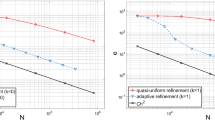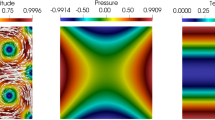Abstract
We consider conforming finite element approximations for the time-dependent Oberbeck–Boussinesq model with inf-sup stable pairs for velocity and pressure and use a stabilization of the incompressibility constraint. In case of dominant convection, a local projection stabilization method in streamline direction is considered both for velocity and temperature. For the arising nonlinear semi-discrete problem, a stability and convergence analysis is given that does not rely on a mesh width restriction. Numerical experiments validate a suitable parameter choice within the bounds of the theoretical results.




Similar content being viewed by others
References
Boussinesq, J.: Théorie analytique de la chaleur: mise en harmonie avec la thermodynamique et avec la théorie mécanique de la lumière. Gauthier-Villars, Paris (1903)
Oberbeck, A.: Über die Wärmeleitung der Flüssigkeiten bei Berücksichtigung der Strömungen infolge von Temperaturdifferenzen. Annalen der Physik 243(6), 271–292 (1879)
Gelhard, T., Lube, G., Olshanskii, M., Starcke, J.-H.: Stabilized finite element schemes with LBB-stable elements for incompressible flows. J. Comput. Appl. Math. 177(2), 243–267 (2005)
Case, M., Ervin, V., Linke, A., Rebholz, L.: A connection between Scott–Vogelius and grad-div stabilized Taylor–Hood FE approximations of the Navier–Stokes equations. SIAM J. Numer. Anal. 49(4), 1461–1481 (2011)
Roos, H.-G., Stynes, M., Tobiska, L.: Robust Numerical Methods for Singularly Perturbed Differential Equations: Convection–Diffusion–Reaction and Flow Problems, vol. 24. Springer Science & Business Media, Berlin (2008)
Lube, G., Rapin, G.: Residual-based stabilized higher-order FEM for a generalized Oseen problem. Math. Models Methods Appl. Sci. 16(07), 949–966 (2006)
Braack, M., Burman, E., John, V., Lube, G.: Stabilized finite element methods for the generalized Oseen problem. Comput. Methods Appl. Mech. Eng. 196(4), 853–866 (2007)
Matthies, G., Skrzypacz, P., Tobiska, L.: A unified convergence analysis for local projection stabilisations applied to the Oseen problem. ESAIM Math. Model. Numer. Anal. 41(4), 713–742 (2007)
Matthies, G., Tobiska, L.: Local projection type stabilization applied to inf-sup stable discretizations of the Oseen problem. IMA J. Numer. Anal. 35(1), 239–269 (2015)
Dallmann, H., Arndt, D., Lube, G.: Local projection stabilization for the Oseen problem. IMA J. Numer. Anal. (2015)
Arndt, D., Dallmann, H., Lube, G.: Local projection FEM stabilization for the time-dependent incompressible Navier–Stokes problem. Numer. Methods Partial Differ. Equ. 31(4), 1224–1250 (2015)
de Frutos, J., García-Archilla, B., John, V., Novo, J.: Grad-div stabilization for the evolutionary Oseen problem with inf-sup stable finite elements. J. Sci. Comput. 66(3), 991–1024 (2015)
Boland, J., Layton, W.: An analysis of the finite element method for natural convection problems. Numer. Methods Partial Differ. Equ. 6(2), 115–126 (1990)
Boland, J., Layton, W.: Error analysis for finite element methods for steady natural convection problems. Numer. Funct. Anal. Optim. 11(5–6), 449–483 (1990)
Dorok, O., Grambow, W., Tobiska, L.: Aspects of Finite Element Discretizations for Solving the Boussinesq Approximation of the Navier–Stokes Equations. Springer, Berlin (1994)
Codina, R., Principe, J., Ávila, M.: Finite element approximation of turbulent thermally coupled incompressible flows with numerical sub-grid scale modelling. Int. J. Numer. Methods Heat Fluid Flow 20(5), 492–516 (2010)
Loewe, J., Lube, G.: A projection-based variational multiscale method for large-eddy simulation with application to non-isothermal free convection problems. Math. Models Methods Appl. Sci. 22(02), 1150011-1–1150011-31 (2012)
Girault, V., Scott, L.: A quasi-local interpolation operator preserving the discrete divergence. Calcolo 40(1), 1–19 (2003)
Ayuso, B., García-Archilla, B., Novo, J.: The postprocessed mixed finite-element method for the Navier–Stokes equations. SIAM J. Numer. Anal. 43(3), 1091–1111 (2005)
García-Archilla, B., Titi, E.S.: Postprocessing the galerkin method: the finite-element case. SIAM J. Numer. Anal. 37(2), 470–499 (1999)
Dallmann, H.: Finite Element Methods with Local Projection Stabilization for Thermally Coupled Incompressible Flow. PhD thesis, University of Göttingen (2015)
Braack, M., Lube, G., Röhe, L.: Divergence preserving interpolation on anisotropic quadrilateral meshes. Comput. Methods Appl. Math. 12(2), 123–138 (2012)
Jenkins, E. W., John, V., Linke, A., Rebholz, L. G. On the parameter choice in grad-div stabilization for the Stokes equations. Adv. Comput. Math. 40(2), 491–516 (2014)
Timmermans, L., Minev, P., Van De Vosse, F.: An approximate projection scheme for incompressible flow using spectral elements. Int. J. Numer. Methods Fluids 22(7), 673–688 (1996)
Guermond, J.-L., Shen, J.: On the error estimates for the rotational pressure-correction projection methods. Math. Comput. 73(248), 1719–1737 (2004)
Arndt, D., Dallmann, H.: Error Estimates for the Fully Discretized Incompressible Navier–Stokes Problem with LPS Stabilization, Technical Report, Institute of Numerical and Applied Mathematics, Georg-August-University of Göttingen (2015)
Arndt, D., Dallmann, H., Lube, G.: Quasi-Optimal Error Estimates for the Fully Discretized Stabilized Incompressible Navier–Stokes Problem. ESAIM Math. Model. Numer. Anal. (2015) (under review)
Wagner, S., Shishkina, O., Wagner, C.: Boundary layers and wind in cylindrical Rayleigh–Bénard cells. J. Fluid Mech. 697, 336–366 (2012)
Grossmann, S., Lohse, D.: Scaling in thermal convection: a unifying theory. J. Fluid Mech. 407, 27–56 (2000)
Bailon-Cuba, J., Emran, M., Schumacher, J.: Aspect ratio dependence of heat transfer and large-scale flow in turbulent convection. J. Fluid Mech. 655, 152–173 (2010)
Author information
Authors and Affiliations
Corresponding author
Additional information
The first author was supported by the RTG 1023 founded by German research council (DFG).
The second author was supported by CRC 963 founded by German research council (DFG).
Appendix
Appendix
Lemma 1
Let \(\epsilon >0\) and \(({\varvec{u}},p,\theta )\in {\varvec{V}}^{div} \times Q\times {\varTheta }\), \(({\varvec{u}}_h,p_h,\theta _h) \in {\varvec{V}}{}_h^{\,div} \times Q_h\times {\varTheta }_h\) be solutions of (2), (3) and (7), (8) satisfying \({\varvec{u}}\in [W^{1,\infty }({\varOmega })]^d\), \(\theta \in W^{1,\infty }({\varOmega })\) and \({\varvec{u}}_h\in [L^{\infty }({\varOmega })]^d\). If Assumptions 1 and 2 hold, we can estimate the difference of the convective terms in the momentum equation
with C independent of \(h_M\), \(h_L\), \(\epsilon \), the problem parameters and the solutions. The difference of the convective terms in the Fourier equation can be bounded as
with \(C>0\) independent of the problem parameters, \(h_M\), \(h_L\) and the solutions.
Proof
Similar estimates can be performed for velocity and temperature. We present the steps for the velocity; for details for the temperature terms, we refer the reader to [21].
We choose the same interpolation operators \(j_u:{\varvec{V}}^{div}\rightarrow {\varvec{V}}{}_h^{\,div}\) and \(j_\theta :{\varTheta }\rightarrow {\varTheta }_h\) as in Theorem 2. With the splitting \(\varvec{\eta }_{u,h}+{\varvec{e}}_{u,h}= ({\varvec{u}}-j_u {\varvec{u}}) + (j_u {\varvec{u}}-{\varvec{u}}_h)\) from (13) and integration by parts, we have
Now, we bound each term separately. Using Young’s inequality with \(\epsilon >0\), we calculate:
For the term \(T^u_2\), we have via integration by parts
Term \(T^u_{21}\) is the most critical one. We calculate using Assumption 2 and Young’s inequality:
Using \((\nabla \cdot {\varvec{u}},q)=0\) for all \(q\in L^2({\varOmega })\), Assumption 1 and Young’s inequality with \(\epsilon >0\), we obtain
Utilizing the splitting according to (13), we have
and use the same estimate as in (35). For the term \(T^u_{32}\), we use that \((\nabla \cdot {\varvec{u}},q)=0\) for all \(q\in L^2({\varOmega })\) and Young’s inequality:
Combining the above bounds (33)–(36) yields the claim. \(\square \)
Rights and permissions
About this article
Cite this article
Dallmann, H., Arndt, D. Stabilized Finite Element Methods for the Oberbeck–Boussinesq Model. J Sci Comput 69, 244–273 (2016). https://doi.org/10.1007/s10915-016-0191-z
Received:
Revised:
Accepted:
Published:
Issue Date:
DOI: https://doi.org/10.1007/s10915-016-0191-z
Keywords
- Oberbeck–Boussinesq model
- Navier–Stokes equations
- Stabilized finite elements
- Local projection stabilization
- Grad-div stabilization
- Non-isothermal flow




